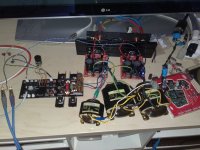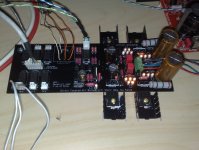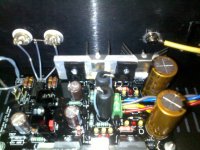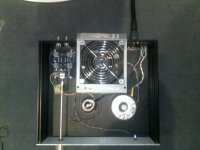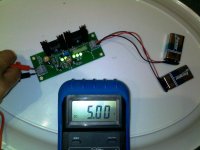The Lightspeed is not sensitive to ambient light. I have had mine playing with the top cover off for years. Several different iterations as well. Once in a great while an LDR will not be sealed well. This LDR should just be thrown out or somehow sealed with some goop.
Uriah
Uriah
Where, in the regs? That has to do with how I wanted the closed loop gain graph of the dc error amp and what kind of phase margin I got, then with subjective evaluation on the point to point proto. There is no rule of thumb 'small' or 'big' for those.
kp93300 - I'm using red LED's, and get ~4.85V from the circuit. As Uriah said, these LDR's are sealed. I've not noticed any problems with light from the PS LED's.
Why are you assuming that? The Silonex devices are potted and isolated from the exterior ambient light. Though I don't know what tolerance it has. I mean, in extreme light conditions it may be affected. But not at all in a closed enclosure.Hi William,
What is the colour LED that you are using ?
I understand that the Lightspeed is sensitive to ambient light . Do you find this a problem with the LEd next to the silonix ?
regards
kp93300
I don't know if a shunt regulated for the LDRs will give any improvement. After all, it is driving a led. Could be a good experiment to hook up a regulator and checking with a scope if the resistor varies with ripple or whatever
I know its not a Lightspeed thread so maybe we shouldnt be jamming this one up with LDR talk. Why dont you steal power from the incredible regulator thats in the same box???
Yes the quality of the power you feed it is the largest improvement you can make.
Uriah
Yes the quality of the power you feed it is the largest improvement you can make.
Uriah
Just to say that finally it's up and running!😎
In the 'wild' but it's working!
The 10 Ohm resistors are temporary while Mills arrives...
Also the pot (a lightspeed will mount there) and the 100 uF caps are temporary, I'll mount sockets to swap different caps.
In the attached photo is near the 'wild' MyRef. 😀
In the 'wild' but it's working!
The 10 Ohm resistors are temporary while Mills arrives...
Also the pot (a lightspeed will mount there) and the 100 uF caps are temporary, I'll mount sockets to swap different caps.
In the attached photo is near the 'wild' MyRef. 😀
Attachments
Another photo then... 😉
the dissy temperature is 63°C (room is at 30°C...) and it sounds great from the start 😛
AC rails are at 14.4V and the 30VA is warm (35°C)
the dissy temperature is 63°C (room is at 30°C...) and it sounds great from the start 😛
AC rails are at 14.4V and the 30VA is warm (35°C)
Attachments
Last edited:
You use too small sinks for 10R set resistors, luckily those Mosfets are war dogs.
When they'll land in the case they will be bolted to the alluminum bottom plate, could this be enough?
By all means. Imagine it copes with now situation. Just don't run it too long for the time being. Nice careful build by the way.
Yesterday i hotrodded my dcb1...i added a 5w 10ohm resistor to the 1w 68r resistors...giving me when measured 7.9ohm
2.04v/7.9 = 258ma
1.73v/7.9 = 218ma
Wow what an improvement!!! The soundstage has opened up wider and deeper, i am hearing sounds all around me(yes sounds even coming from behind me!!!). As a result i can tell where singers or instruments are very easily, and can even differentiate between backing singers. Now this is what i call Holographic. Detail has also gone up a notch and sounds more dynamic, yet the music never grates, i just want to keep on listening....BUT...
After listening for about 30mins (Yes i could tell all the above with just 30mins of listening!) i checked to see the temperature on the mosfets, by touching them with my finger, OUCH way too hot cant touch it very long before it burns, so i took out some heatsinks from an old computer powersupply that doesnt work and listen again for about 30mins, this time the temperature of the mosfets are cooler then before but still too hot, and there is no way im going back to 60ma after hearing it at circa 200ma!!! So i take out the 12v fan from the computer power supply and connect it to an unused 12v tap on the small toroid. After another 30mins of listening i checked the temperature of the mosfets and they are cool
Next up i will install the fan into the cover of the chassis, and i will try the salas shunt reg to run the Optivol
Special thanks to Salas, Nelson Pass and all who participated to make the DCB1 possible
2.04v/7.9 = 258ma
1.73v/7.9 = 218ma
Wow what an improvement!!! The soundstage has opened up wider and deeper, i am hearing sounds all around me(yes sounds even coming from behind me!!!). As a result i can tell where singers or instruments are very easily, and can even differentiate between backing singers. Now this is what i call Holographic. Detail has also gone up a notch and sounds more dynamic, yet the music never grates, i just want to keep on listening....BUT...
After listening for about 30mins (Yes i could tell all the above with just 30mins of listening!) i checked to see the temperature on the mosfets, by touching them with my finger, OUCH way too hot cant touch it very long before it burns, so i took out some heatsinks from an old computer powersupply that doesnt work and listen again for about 30mins, this time the temperature of the mosfets are cooler then before but still too hot, and there is no way im going back to 60ma after hearing it at circa 200ma!!! So i take out the 12v fan from the computer power supply and connect it to an unused 12v tap on the small toroid. After another 30mins of listening i checked the temperature of the mosfets and they are cool

Next up i will install the fan into the cover of the chassis, and i will try the salas shunt reg to run the Optivol
Special thanks to Salas, Nelson Pass and all who participated to make the DCB1 possible

Attachments
Would be nice to know if theres a limmit (the current) where it starts to sound better,and if it´s an upper limmit where it don´t sound any better..
could you hear any difference on the high CCS current whether the FETs were too hot or cool or very warm?
Hi Andrew, yes i do remember at the time thinking, that they sounded better when the fan was on them, but if it really was better, it would of been a very minimal improvement, maybe cleaner sounding, but not as big an improvement as going from 60ma to 240ma. I should also state that before i went up to 240ma i went to 80ma and did notice an improvement, but again it was slight, but it did improve with the soundstage increasing in depth and width and sounds seeming to float in the room, again more of a 3d sound just not to the extent of going up to 240ma.
Alon
Alon
F5 uses same transistors.. 1.3A !!
😱 Hmmmm thats got me thinking...How high can i take the current without them getting hot, while the fan is on them

Guess im gonna have to experiment 😀
Alon
Those Mosfets still amaze me with their ruggedness. So tiny sinks and they survived. Didn't I tell to use proper sinks or bolt to thick floor so many times? You can't run on same sinks you use for regular setting a hot rod. OK, killing a Mosfet is no big deal, but if someone uses a DC amp without output relay DC sense, bye bye speakers. OTOH, when prepared rightly the anti environmental setting attitude has some subjective benefits.😀
- Home
- Amplifiers
- Pass Labs
- Building a symmetrical PSU B1 buffer
